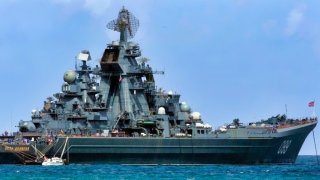The Russian Navy's Ukraine War Nightmare Just Won't End
Ukraine's Navy, despite being relatively small, has significantly impacted Russian naval assets in the Black Sea since the start of the Russian invasion in February 2022. According to Ukrainian Navy spokesperson Dmytro Pletenchuk, Ukraine has disabled or destroyed about a third of Russian warships in the region.
Summary: Ukraine's Navy, despite being relatively small, has significantly impacted Russian naval assets in the Black Sea since the start of the Russian invasion in February 2022. According to Ukrainian Navy spokesperson Dmytro Pletenchuk, Ukraine has disabled or destroyed about a third of Russian warships in the region.
-The tactics employed include missile strikes, sea drone attacks, and other innovative methods aimed at reducing Russia's maritime capabilities. Notable successes include targeting a Russian amphibious landing ship in Sevastopol and the strategic use of the Magura V5 maritime drone, capable of carrying substantial payloads over long distances.
-These efforts have critically weakened Russia's Black Sea Fleet, historically a dominant force in the region, and continued support from NATO allies is bolstering Ukraine's capacity to challenge Russian naval operations further.
Under Siege: The Weakening of Russia’s Naval Power in the Black Sea
Ukraine’s navy may be small, but it is continuing to hammer Russian assets in the Black Sea.
According to Kyiv, Ukrainian forces have sunk or disabled roughly a third of all Russian warships since the invasion commenced back in February 2022. Ukraine’s Navy spokesman Dmytro Pletenchuk said that a Russian amphibious landing ship resting in dock in Sevastopol was targeted in a strike last month.
The ship, once part of Ukraine’s Navy, was captured by Russian forces during the Crimea annexation in 2014. Although Moscow appears to have the advantage when it comes to its ground campaign, it has struggled to contend with Kyiv’s sustained successes targeting its naval assets in the Black Sea.
Ukraine uses missile strikes, sea drone attacks, and other tactics in order to minimize Russia’s ability to strike from the seas.
If Ukraine’s assertions are accurate, it would likely mean that Russia has only 3 working landing ships remaining in the Black Sea out of the 13 it started with at the beginning of the invasion.
Introducing Russia’s Black Sea Fleet
Moscow's Black Sea Fleet's official primary headquarters and all facilities are located at the Sevastopol Naval Base in occupied Crimea. The remainder of the fleet’s assets are based throughout the Black Sea and the Sea of Azov. Founded in the late 18th century by Prince Potemkin, the Black Sea Fleet is hugely symbolic to the Russian Federation.
The fleet perhaps experienced its peak in power during the tail end of the Cold War, when the USSR controlled the entire north and east of the Black Sea. Since Romania and Bulgaria were members of the Warsaw Pact and were governed by pro-Soviet regimes, the Black Sea Fleet was dominant. Like all of the USSR’s military services and assets following the collapse of the country post-Cold War, the Black Sea Fleet suffered from debilitating budgetary constraints and other degradations.
The Ukrainian government ordered the establishment of its own Navy during this time period, and some of the Black Sea Fleet’s ships declared themselves Ukrainian. Subsequently, former Russian President Boris Yeltsin and former Ukrainian President Leonid Kuchma negotiated a joint Russo-Ukrainian fleet under bilateral command.
For several years, this dynamic functioned. However, the annexation of Crimea by Russia in 2014 forced the Ukrainian Armed Forces and the Ukrainian Navy out of the peninsula.
The state of Russia’s Black Sea Fleet today:
Since Russia’s invasion commenced, Ukraine has been craftily and ingeniously striking the fleet. In fact, Kyiv’s fleet of maritime drones has shaped a large component of the ongoing war.
Last year, a secretive unit of Ukraine’s military intelligence agency carried out an attack targeting the Sergey Kotov warship. The specialized unmanned aerial vehicle (UAV) behind the attack was the Magura V5. This small motorboat appears pretty harmless from afar but can pack a hefty punch when deployed.
Ukrainian engineers designed this drone to reach targets as far as 500 miles away, enabling it to reach the Crimean Peninsula and even the Russian coastline. According to the BBC, the Magua can carry 250kg of payload, which is more than enough to sink a Russian warship.
Since drones are so small and maneuverable, they are difficult for Russia to take out before striking.
In a previous attack in December, Kyiv said it had taken out the Novocherkassk landing vessel in Crimea with long-range cruise missiles. Additionally, Ukrainian forces launched a barrage of frequent cruise missile and UAV strikes targeting Russian radar facilities and other defense assets in Crimea.
At least two Russian early warning and control airframes were also destroyed earlier this year, reducing Moscow’s intelligence-gathering capabilities greatly. NATO allies, including the United Kingdom and France, have provided many of these strike assets to Kyiv, including the Storm Shadow and SCALP-EG, respectively. Even though Ukraine is short on missiles, it has tactfully deployed the few in its possession to effectively hamper Russia’s long-held naval dominance in the Black Sea.
With at least a third of its fleet disabled or destroyed, Russia’s naval capabilities are crippled. As Kyiv receives additional munitions from the West and engineers more homegrown sea-drones and other capabilities, Moscow’s lingering warships are in trouble.
About the Author: Maya Carlin
Maya Carlin, National Security Writer with The National Interest, is an analyst with the Center for Security Policy and a former Anna Sobol Levy Fellow at IDC Herzliya in Israel. She has by-lines in many publications, including The National Interest, Jerusalem Post, and Times of Israel. You can follow her on Twitter: @MayaCarlin.


